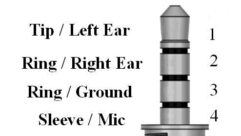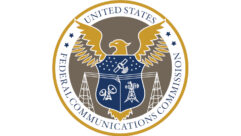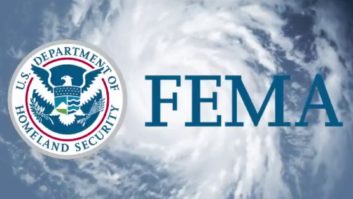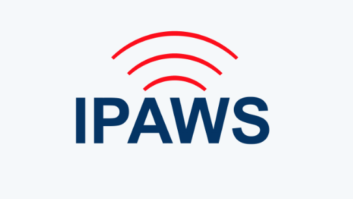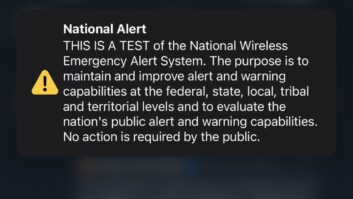WASHINGTON Only a few hurdles remain before the Federal Emergency Management Agency officially adopts Common Alerting Protocol version 1.2. That step will launch the 180-day countdown for broadcaster compliance and eventually the long-awaited EAS upgrade.
FEMA is still waiting for OASIS, a standards setting organization, to give the go-ahead on CAP v1.2 before it begins lab tests on a variety of field equipment, including EAS encoders and decoders, to measure compliance with CAP.

iStockphoto/Roydee The vetting process could last several months before FEMA formally adopts CAP — possibly as soon as August — and a new public warning era dawns, according to public warning experts and government officials.
A nationwide test of the existing EAS also is in the works; regulators are aiming for January 2011. The Federal Communications Commission has proposed a rulemaking to make that possible, as Radio World has reported.
Spring forward
The OASIS Emergency Management Technical Committee presented modified specs for CAP to the full OASIS board in March. FEMA, which approved the CAP profile last fall, expects OASIS to finalize the alerting protocol standard before the end of May.
“Once we get the OASIS standard, FEMA will move forward to adopt CAP v1.2 by late August, we hope,” said Damon Penn, assistant administrator for the National Continuity Programs Directorate at FEMA. “Then we’ll have full vendor participation in the program and begin the 180-day conformance clock for broadcasters and other stakeholders.”
Any delay by OASIS in the formal approval of the CAP profile likely would cause FEMA to delay starting the adoption clock until sometime in the fourth quarter of 2010, according to experts.

NAB has emphasized the reliability of radio during emergencies. At the recent EAS Summit, the association stressed that FM radio in cell phones would be a complement to all alerting systems. CAP v1.2 will become the standard for FEMA’s Integrated Public Alert and Warnings System, which will be launched sometime after the broadcaster readiness deadline. Observers describe IPAWS as the integration vehicle designed to bring disparate warning systems under one protocol.
FEMA officials reiterated the new EAS will include more diverse warning capability to reach a wider population, including text messages, Internet warnings and multiple language messaging.
“Broadcast radio and TV and cable shall remain the backbone of EAS. But our population is changing and people don’t necessarily spend their time listening to the radio or watching TV like they used to,” Penn said.
Penn did confirm that FEMA no longer sees RBDS as “fitting into a national warning program,” even though IPAWS architecture supports RBDS technology. “Certainly individual states can utilize the technology, and some have already. It just doesn’t suit our needs at national.”
He cited support of FEMA’s efforts from EAS stakeholders at the National Alliance of State Broadcasters Associations 2010 EAS National Summit, which was held with backing from NAB in Washington in March. See the agenda at www.nasbaonline.net.
FCC, FEMA in lockstep
“Equipment vendors are eager to roll. They are very positive they can meet the compliance deadline to provide enough CAP-compliant EAS encoders and decoders and upgrades to existing equipment in the field,” Penn said.
Harold Price, spokesman for Sage Alerting Systems, cited estimates that at least 10 percent of the broadcast industry has already upgraded to devices that can take the updated CAP and place it directly on the air as an EAS alert. (See sidebar story on broadcaster preparation.)
Broadcasters have known since 2007 that they must be able to receive CAP-formatted messages 180 days after FEMA adopts CAP, Price said.
CAP to EAS: What It Means for You Radio station operators will be affected when FEMA officially adopts the updated Common Alerting Protocol for use in an improved emergency alert system.
That adoption will begin a 180-day countdown clock for broadcasters to have equipment capable of receiving and decoding CAP messages installed.
Darryl Parker, senior vice president of manufacturer TFT Inc., said the FCC is just starting the process to make changes to Part 11 of the commission’s rules, so broadcasters need to move slowly at this point. “Until the regulatory process is settled, it will be hard for radio stations to prepare for requirements that the FCC has yet to define.”
The FCC’s EAS rules will need to be revised in order to accommodate CAP; the commission is asking for informal comments on how Part 11 rules should change. For example, it suggested, commenters might address equipment requirements, organization, operations, testing and access for people with disabilities and non-English speakers, as well as how EAS participants should configure their networks to CAP-formatted alerts disseminated by new delivery systems like wireline, Internet or satellite.
“Stations should comment in regards to all manner of things that should be changed with EAS rules. Stations should consider their roles in EAS and suggest how changes in the rules would permit them to be more responsive in alerting their listeners to emergency situations,” Parker said.
Since it is clear that some form of CAP distribution will be implemented, broadcasters eventually will need to purchase new CAP-capable EAS encoders/decoders or upgrade current equipment with a downloadable software update in some cases. Several EAS equipment manufacturers have been shipping CAP compliant gear for the past 18 months.
“Any new purchases now should be made with CAP in mind. Don’t get an EAS-only solution at this late date,” said Harold Price of Sage Alerting Systems.
Options may include purchasing a CAP converter that sends EAS alerts to an existing legacy EAS device, he said.
“If you need to buy right now, the best option is to purchase an integrated single device that can do both CAP and EAS,” according to Price.
Broadcasters who are not CAP-compliant at the end of the 180 days will likely be able to apply to the FCC for a temporary compliance waiver.
— Randy J. Stine The conformance testing labs are in place at Eastern Kentucky University, where preliminary work with the CAP v1.2 protocol is taking place, Penn said. “CAP testing there cannot begin in earnest until OASIS approves the final protocol.”
The FCC has been in lockstep with FEMA on planning a new EAS. The commission’s recently released National Broadband Plan calls for the FCC to explore and develop a multi-platform, redundant, next-generation alert system that uses broadband capabilities, according to Jamie Barnett, chief of the FCC’s Public Safety and Homeland Security Bureau.
“We are launching into the broadband world. It will be interesting to see how broadband will play into all of this,” Barnett said.
The broadband plan also asks the president to clarify agency roles on the implementation and maintenance of a next-generation alert and warning system.
“This would be an important step toward improved, timely and coordinated federal implementation of next-generation alerting systems,” Barnett said. “We expect to take a more active role in implementation of next-generation EAS, in coordination with FEMA, via testing and technical guidance.”
FEMA, FCC and the National Oceanic and Atmospheric Administration are federal partners in developing an enhanced EAS. FEMA was given the responsibility of leading the project by President George W. Bush.
The FCC is eager to implement nationwide testing of the enhanced EAS, experts note. It has a pending rulemaking proposal (EB docket 04-296) that calls for changing the commission’s Part 11 rules governing EAS to provide for annual, national EAS testing and data collection from such trials. Comments are due 30 days after Federal Register publication, which had not occurred as of March 30.
FEMA will provide alerts
“The Alaska statewide test of the EAS in January was a good starting point, but national tests will allow us and our federal partners to ascertain how well EAS would perform if there were a presidential activation,” Barnett said.
The Alaska EAS test included an Emergency Alert Notification, which would allow the president to address the national during a national emergency; it was issued by FEMA at its headquarters in Washington (Radio World, Feb. 10).
The FCC is looking at outreach efforts to educate broadcasters and other stakeholders on the new protocol, but “we are not in position to offer training” on CAP implementation, Barnett said.
Meanwhile, NOAA continues to make incremental changes to conform to CAP, both online and in its weather radio alerts and broadcasts, said Herb White, dissemination services manager for NOAA’s National Weather Service.
NWS continues to place markers within its messages to indicate the call to action using the original CAP 1.1 that allows CAP software to extract information, White said. The newer version of CAP will be implemented once the Weather Radio Improvement Project is initiated next year. The WRIP program is intended to consolidate communications infrastructure in NWS field offices.
On the Alert for Radio The 2010 EAS National Summit was held in March in Washington, presented by the National Alliance of State Broadcasters Associations with support from the NAB.
The event’s planning committee is a list of opinion leaders among broadcasters on the alerting issue.
– Ann Arnold, President, Texas Assn. of Broadcasters, Co-Chair
– Whit Adamson, President, Tennessee Assn. of Broadcasters, Co-Chair
– Mark Allen, President & CEO, Washington State Assn. of Broadcasters
– Ann Bobeck, Senior VP & Deputy General Counsel, NAB
– Art Brooks, President, Arizona Broadcasters Assn.
– Robert Fisher, President & CEO, Nevada Broadcasters Assn.
– Suzanne Goucher, President & CEO, Maine Assn. of Broadcasters
– David Layer, Senior Director, Advanced Engineering, Science & Technology, NAB
– Jackie Lett, President, Mississippi Assn. of Broadcasters
– Christine H. Merritt, President, Ohio Assn. of Broadcasters
– Louise “Lou” Munson, President & CEO, Louisiana Assn. of Broadcasters
– Robin Oxford, Director of State Assn. and Membership Outreach, Government Relations, NAB
– C. Patrick Roberts, President, Florida Assn. of Broadcasters
– Paul Rotella, President & CEO, New Jersey Broadcasters Assn.
– Sharon Tinsley, President, Alabama Broadcasters Assn.
– Michelle Vetterkind, President, Wisconsin Broadcasters Assn.
– Larry Walke, Associate General Counsel, NAB
– Regina Sullivan, Principal, RSullivan & Associates, Summit Coordinator FEMA also will boost the number of Primary Entry Point radio stations, from the current 40 up to 75, by the end of 2011. PEP radio stations are viewed as a “network of last resort” to air presidential messages in a post-event scenario, said Watt Hairston, project manager for the Primary Entry Point Advisory Committee. PEPAC helps FEMA and is responsible for managing program-related equipment at PEP stations.
Clay Freinwald, chair of the Washington State Emergency Communications Committee, said that while a few pieces of an enhanced EAS are yet to be fit together, the ball is rolling down the road.
“The existing EAS as we know it will continue for a while yet,” Freinwald said. “All of these different elements will take some time to come on board and improvements made. Broadcasters will have to buy new EAS equipment or upgrade what they have. Then they’ll have some enhanced features and capabilities.
“It’s very reassuring that FEMA has said it will have the ability to provide CAP alerts once the 180 days is up. At least broadcasters and cable operators will have something to plug into the mandated equipment.”
Funding?
Might there possibly be government grant money to help stations pay for CAP-compliant EAS encoders/decoders? That’s unclear.
Rep. Mike Rogers, R-Ala., ranking member of the Subcommittee on Emergency Communications, Preparedness and Response, said at the EAS Summit that if federal grant assistance were made available, it could help some broadcasters who have been unable to upgrade to comply.
An aide to Rogers told Radio World that his office is talking to the NAB to identify specific costs for CAP-compliance equipment. “As the deadline for CAP compliance draws near, FEMA may need to assess the situation on a case-by-case basis, since the possibility remains that some assistance may be needed. But at this juncture, Rogers said, the prospect that there would be some kind of federal financial support to most stations for their new EAS equipment is unknown.”
Meanwhile, IPAWS is coordinating with other FEMA divisions to see if EAS language can be added to existing FEMA grant criteria, a source told Radio World.

